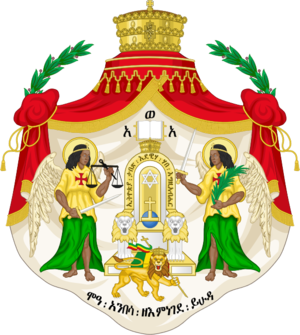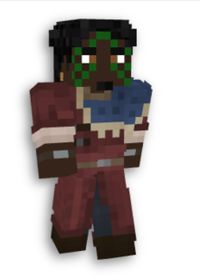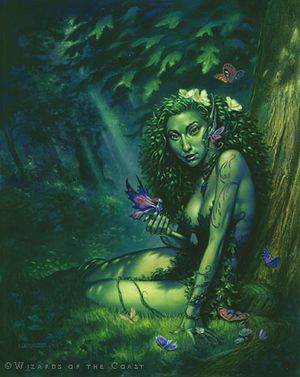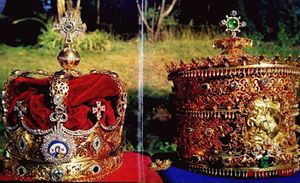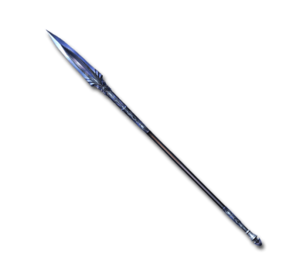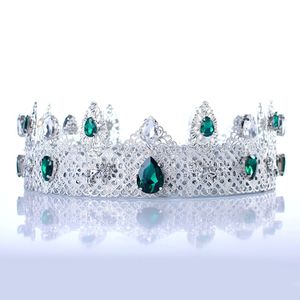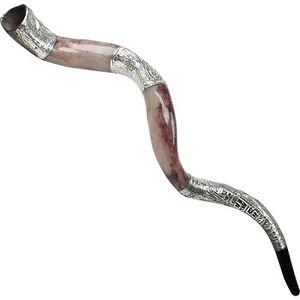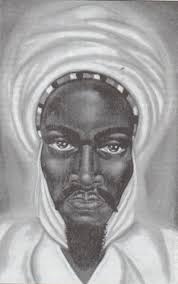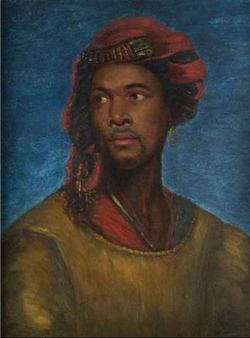Chieftaincy of Ghanyah
|
| ||||||||||||||||||||||||||||||||||||||||||||||
The Chieftaincy of Ghanyah, also known as the Chieftaincy of Southerons or the Emerald State, was a nation founded of the Atlasian deserts in 1669. Holding a large mass of the Farfolk populace, the Chieftaincy has become one of the few havens to the subrace; though unlike others, the Ghanyans have held true to their tribal roots with hints of feudalism in its central government. The Southeron people have found refuge and haven in this nation until it's succession into the Rasdom of Melle
Contents
National Information
Motto : "One is born, One dies; the land grows"
National Salute : Fists Together, Head tilted upwards
Officiated Tribes :Khonma, Ọkarachi
Settlements :Yeondar, Kharmandal, Khonma
Diplomacy
Allies : War Nation of Krugmar, Kingdom of Nottingham
Neutral : Consulary Republic of Holm, Kingdom of Kaz'Ulrah, Crown of Renatus-Marna, Duchy of Riviä
Enemies : Kadarsi Sultanate, Dominion of Malin, Druidic Order
Appearance
Like most Southerons, Ghanyans are typically tall and dark-skinned. They usually wear light or revealing clothing with a large quantity of Jewelry on them, gold being the most common. Due to their militarized and aggressive society, it is not uncommon to find wounds, scars, or other forms of injury littered across Ghanyan men; though they are typically buff or fit. Higher ranked men and women usually have face paintings that sport Ghanyah's national colors; Green, Yellow, Red, and Black. Those descended from slaves usually have brandings on them, many tribes have inducted their old branding marks into the natural symbols of their tribes. They have coarse or curly hair with varied eye colors.
Tradition
In Ghanyan tradition, naturalism is quite important - although magic is allowed, a typical Ghanyan would scowl at a plant that is magically grown by a druid rather than a plant that is grown naturally by a farmer. Fighting is a very big part of Ghanyan culture, although it is unsupported for women to fight physically. Emerald is the most common jewelry in Ghanyah, a homage to its national colors and lush green landscape.
Men
In Ghanyan society, men are the destined leaders. Society expects for them to become warriors, soldiers, even Warlords; making it a shame to be frail or weak as a man.During the reign of Balrogiin Sr, men who were considered weak and frail were given the option of becoming "Magisters", those who refused and were unable to find suitable jobs were castrated and forced to become Eunuchs. Men are meant to hunt, procreate, and lead/protect the women and children. At young ages they are drafted as soldiers if necessary, it is a custom in most Ghanyan tribes to hold an Ageni(Uh-jen-yi) for their sons on their 12th birthday, which means "Hunters Fest" in the Ghanwua Language. During an Ageni, men are given their first customary spears and shields; which they then take to "bleed" during their first hunt.
Women
In Ghanyan society, women are seen as graceful and majestic; too graceful to bother themselves with the jobs of Men, they are typically expected to become housewives, cookers, cleaners, gardeners, tailors even. Women who go on to become soldiers, builders, or scholars are typically seen as barbaric or unorthodox. Even the power of women Regnants are challenged due to their sex. At the age of 15, it is accustomed to most tribes for "Kradas" to be held for women, during Kradas women are typically gifted jewelry; it is a party where women are meant to find husbands. Though, it is not uncommon for the justicial system to be more leniant on women who commit crimes. Ghanyan women are seen as glue that holds the families together A Ghanyan woman who holds true to her tradition deserves the utmost respect.
Magic
Magic in the Chieftaincy of Ghanyah is generally a unaccepted thing, although not illegal, it is seen as a practice of the weak. The only popularly accepted magic being Shamanism, mainly Elementalism.
Corruption and Dark Arts
"Corruption is the small piece of land in the world of water, just enough to live on is good; but without it or with too much of it and we will perish" - Valdun, 1669
In Ghanyan culture, necessary evils are understandable - there needs to be darkness for light to exist. Although socially unacceptable, there are no set or unofficial laws against the practice of Dark Arts, making them as lawfully sustainable as all other magics. Most Ghanyan citizens will scowl at the practice of Dark Arts as if they were another disgraceful magic, however Ghanyan Officials are not required to act on things and will most likely not react to them if unpublicized.
Voidal Magic
Voidal Magic is one of the most heinous forms of magic practiced in Ghanyah, shamed for its known drawbacks of physically weakening and tiring a caster - a standard Ghanyan would believe that nothing is worth becoming frail and weak by choice. Voidal mages are generally mocked, and someone who publicly practices the art form will be at the discretion of society, its respective members, and its law enforcers. Most arcane casters do not use their magic openly in the borders of Ghanyah unless it is necessary.
Divine Magic
Divine Magic, or Dietal Magic, is the most publicly accepted form of magic in the Chieftaincy. Shamanism being the most favored. Having the favor of a supreme diety is seen as the highest blessing in Ghanyah. Druidism is tolerated for its naturalistic qualities, though the ideology of orders is seen as a disgraceful way to maintain the magic. Shamanism is favored for its spiritual qualities, Elementalism being the most preferred. However, Clericalism and Paladinism have varied opinions.
Technology
Ghanyans fall behind on many technological advances, their traditionalism viewing much of the worlds newer customs and technology as unnecessary or debasing. For example, railroads are seen as irrelevant with the large quantity of legs and mounts - they are seen as attempts to lazify the mass population, making it generally unacceptable.
Patroness
Although most Ghanyans adhere to the basic tenants of the Shamanistic faith, the Patroness Saint of Ghanyah is named 'Veal'(pronounced Veil). She is known as the Spirit of the Oasis, other names being "Mother Spring" or "Zpring". Most Ghanyans believe that she is the Oasis itself. In her humanoid form however, she is seen as a woman made entirely of plants with long curly hair and bewitching eyes - similar to the Bryophites.
Artifacts
(These Artifacts can be stolen as lore items and sold back to the Chieftaincy for large sums of Mina.)
Dynastic Crowns
On the left is the Crown of the Itege and on the right is the Crown of the Negus. Arguably the most important Artifacts ever invented in the nation, they are the Crown Jewels of the nation and are only worn for ceremonial reasons. They are both made purely of gold and the ghanyan renowned material, emerald.
The Veal'kabi
The Veal'kabi is a diamond spear gifted to the Negus upon his coronation, rumored to be blessed by Veal, the spirit of the oasis.It directly translates to "Veal's Spear"
Emerald Coronet of Spring
The Emerald Coronet of Spring, also known as the Heir's Crown or Spring Coronet, is the crown worn by a Le'ul Ras or Le'elt Rasi when they come of age - it is a crown made purely of silver and emerald.
Ye Shofar Nagast
Ye Shofar Nagast(Trans. The Horn of Kings) is a long blow horn made of a Rams horn. A prized possession of the Negus, it is a signalling horn that is able to emit a wailing noise that stretches out to the whole capital - made to signal for raids, the birth of an heir, drills, and other events of urgency.
Language
See page Ghanwua.
History
Before Ghanyah, the desert and neighboring savannah was a post to several displaced southerons and other forms of nomadic groups that were dominantly of Farfolk origin, many of which considered the desert their homes under the discretion of the orcs - who seldom used the desert and savannah upon their landing in Atlas.
The Southerons are accustomed to the heat, the hottest places usually laying in the south - However on Atlas, the desert was North; which caused many Southeron groups who stuck to their ties to migrate there, some even after enslavement. Those already settled in the deserts were fearful that the new migrants would either show them hostility or would attract unwanted attention from powerful nations. The migrants were afraid that many of them would be captured and enslaved – this lead to the forming of tribes out of fear of aggression.
These tribes were mainly populated with the new influx of Southeron people who settled in temporary huts before moving elsewhere in the desert, only accepting those that were either blood-related to them or were proven trustworthy by their Chiefs. However, some tribes began to claim land – the most historically popular of these settled tribes being the “M’Baku Tribe” who’s land held members of their bloodline, families who were allowed protection by previous Chiefs, and even other tribes; it is undocumented how long they were landed, but there are legends that they were settled there even before the great migration to Atlas.
During this time, they were generally unpopular; their positioning in the Oasis was both resourceful and provided them a major upper hand against all other desert settlers, making them the most powerful independent tribe in the desert and savannah region in the times pre-dating Ghanyah. For a time though, they were peaceful and non-threatening – although they held very strict and peculiar isolationism policies.
It was not until Juumane Nagast of the M'Baku Tribe, at the young age of thirteen, became Chief in 1667 that the tribe began to show their hostility to their neighbors, enslaving those that were not to their liking and claiming lands that they felt would benefit their tribe - though, this was against the will of the young ruler, it was done by autonomous/rebellious vassals who did not respect him.
Offering to convert to and spread Shamanism, adhere to their way of life, and help re-establish Orcish rule in the desert; Juumane cemented a lasting deal. Krugmar assisted the M’Baku Tribe in securing power in their conquered lands to settle the rebellious vassals. With help from Krugmar, all vassal rulers who refused the will of the young leader were either exiled or executed.
With control permanently enforced in M’Baku, Grand Chief Juumane and his bastard brother Commander Zyrrin began to establish a governmental system that included more tribes than just the M'Baku tribe and its vassals, extending their power and reach throughout the desert and savannah.
It was not until Juumane bought a slave by the name of Valgarai that he began to form his society into a nation. Valgarai was previously an Orcish slave, a servant of the Lak Clan. Although an slave, he held much knowledge . He took time to learn the history of the desert and the Ghanwua Peoples, eventually becoming a good confidant and overall paternal figure of Juumane. With Valgaraiss extensive knowledge, diplomatic experience, exceptionally old age, and history of serving Rex's - he became Juumanes first Advisor; eventually holding the title Advisor-Regent, although still technically in servitude.
Alongside his first Advisor Valgarai, Juumane formed the Chieftaincy of Ghanyah on the 2nd of Snow’s Maiden, 1662. As the first ‘Negus’ of Ghanyah, he became popular for his controversial laws centered around the imperialization of the nation and enforcement of shamanism on his subjects.
After some time with the influx of foreigners, the overall society of Ghanyah had changed – their multi-cultural society began to phase into one, creating the newfound broken language of ‘Ghanyan’ which held several influences especially from the ancient Ghanwua peoples, the Orcs of Krugmar, and the Elves of the Warhawkes who settled nearby.
After a large period of peace and prosperity, Juumane became overwelmed with his imperialistic views, often seen as greed, giving him the title of "Juumane the Imperialist". Juumane ‘the Imperialist’ of M’Baku became documrnted by the Ghanyan people as the first Negus who held nationalist views at a racial level around the nation, although Ghanyah at the time kept to its tribal ties, he was also known for his assistance along the side of Renatus-Marna in the Second Atlas Coalition War. He held a strong view that the Farfolk should unify under a banner that actually stood for them rather than allow them to subjugate under more powerful empires.
He sought to dignify and preserve all the various aspects of Farfolk culture by creating seperate cities dedicated to each large cultural group ; the subjugation of Kharmandal was a basis for a Subudai city, the creation of Yeondar served as an Easterner division of trade, and he also desired the neighboring Kadarsi Sultanate to serve as a Rasdom devoted to the Qalasheen; this lead to his famous ‘Rite of Usurpation’ reluctantly written in 1670 by his Advisor-Regent, Valgarai. Juumane, accompanied with his Advisor-Regent Valgarai and Commander Zyrrin began an array of hostilities against the Kadarsi Tribe and Sultanate of Haria; they officially declared war in 1671 with The Kingdom of Nottingham and Warnation of Krugmar called in as co-belligerent allies.
The Chieftaincy of Ghanyah eventually lost the war at the hands of the Kadarsi and their mercenaries, greatly weakening their stance in the grand scheme of things - this was followed by the death of Juumane and emergence of the September Prince in the nearby wonkawoods, which inevitably lead to the fall of Ghanyah. Many of Ghanyah's strongest tribes, however, stayed behind and founded the Rasdom of Melle.
Inheritance Tree
| Juumane Nagast | |
| First Negus | |
| Reign: 1669 - 1673 | |
| Coronation: 10th of Grand Harvest, 1667 | |
| Predecessor: Title Created | |
| Regent: Valdun Evolasti | |
| Born: 12th of The First Seed, 1654 | |
| Spouse: Unmarried | |
| Tribe: The M'Baku Tribe | |
| Father: Balrogiin Nagast of the M'Baku Tribe | |
| Mother: Katara Kiseri of the Ọkarachi Tribe | |
| Iýsakye Nagast | |
| Negus of Ghanyah | |
| Reign: 1674 - | |
| Coronation: REGENCY | |
| Predecessor: Juumane Nagast | |
| Regent: Valdun Evolasti | |
| Born: 3rd of The Grand Harvest, 1667 | |
| Spouse: Unmarried | |
| Tribe: The Ọkarachi Tribe | |
| Father: Ajevel Kenyatta | |
| Mother: Katara Nagast of the Ọkarachi Tribe | |
